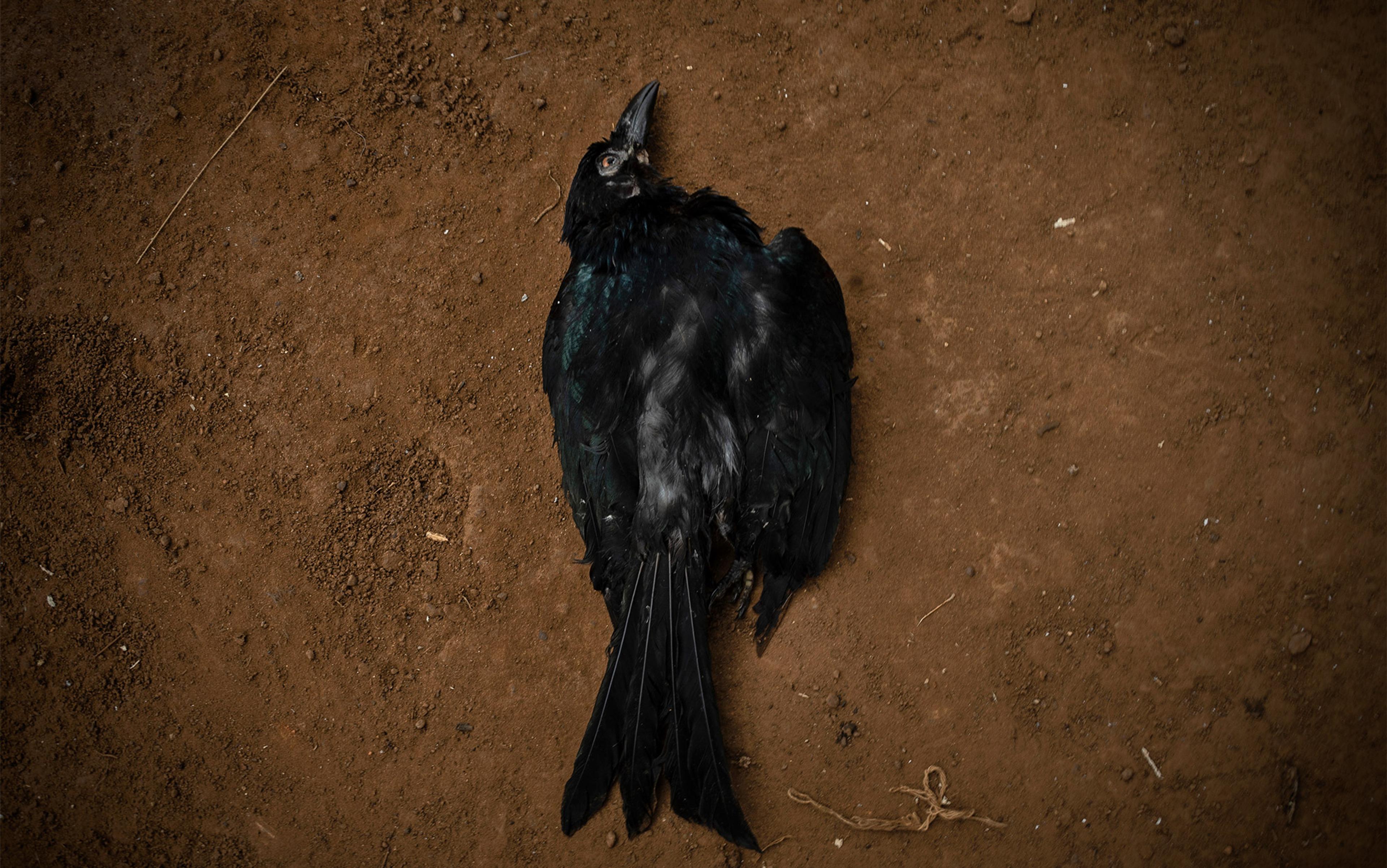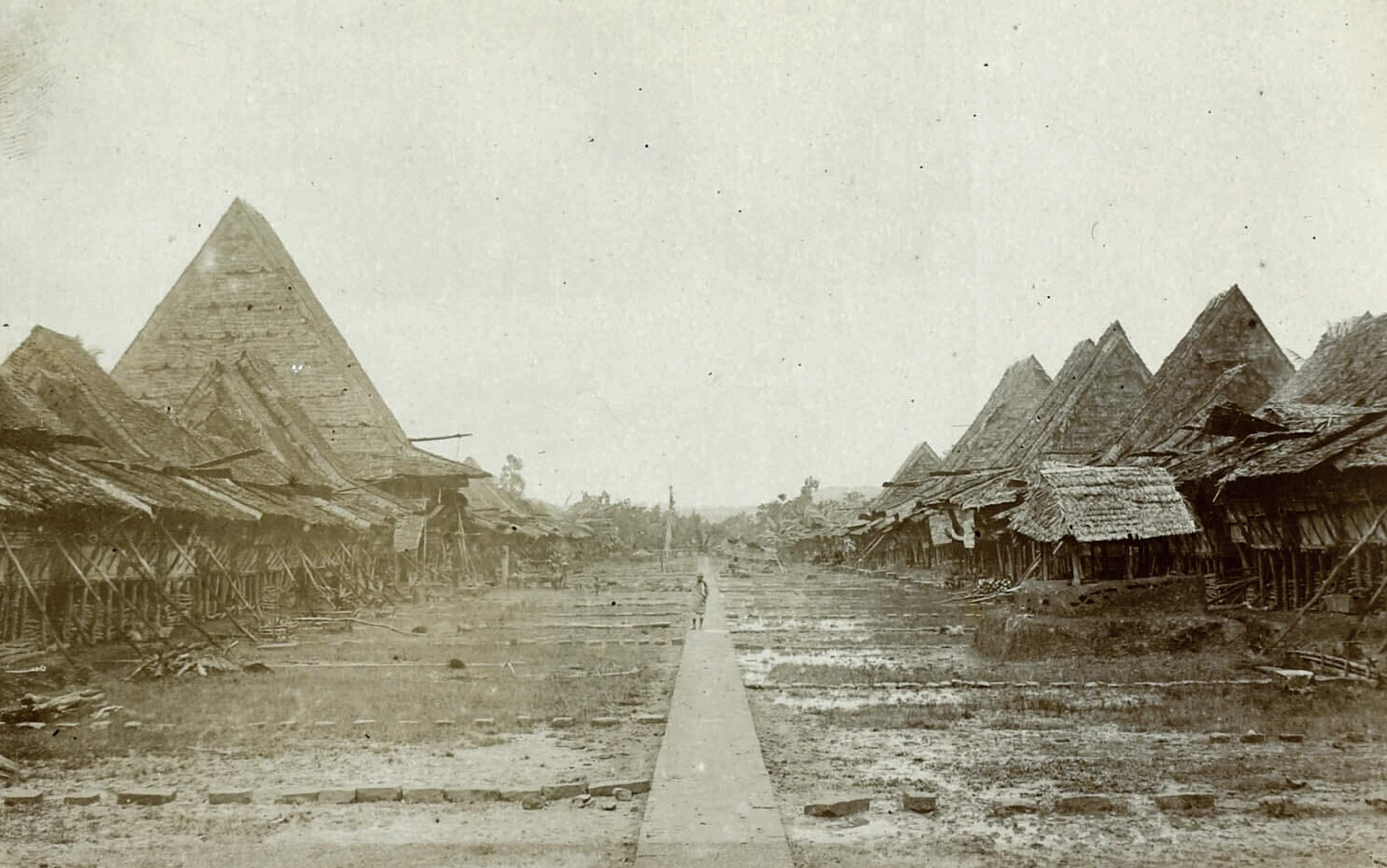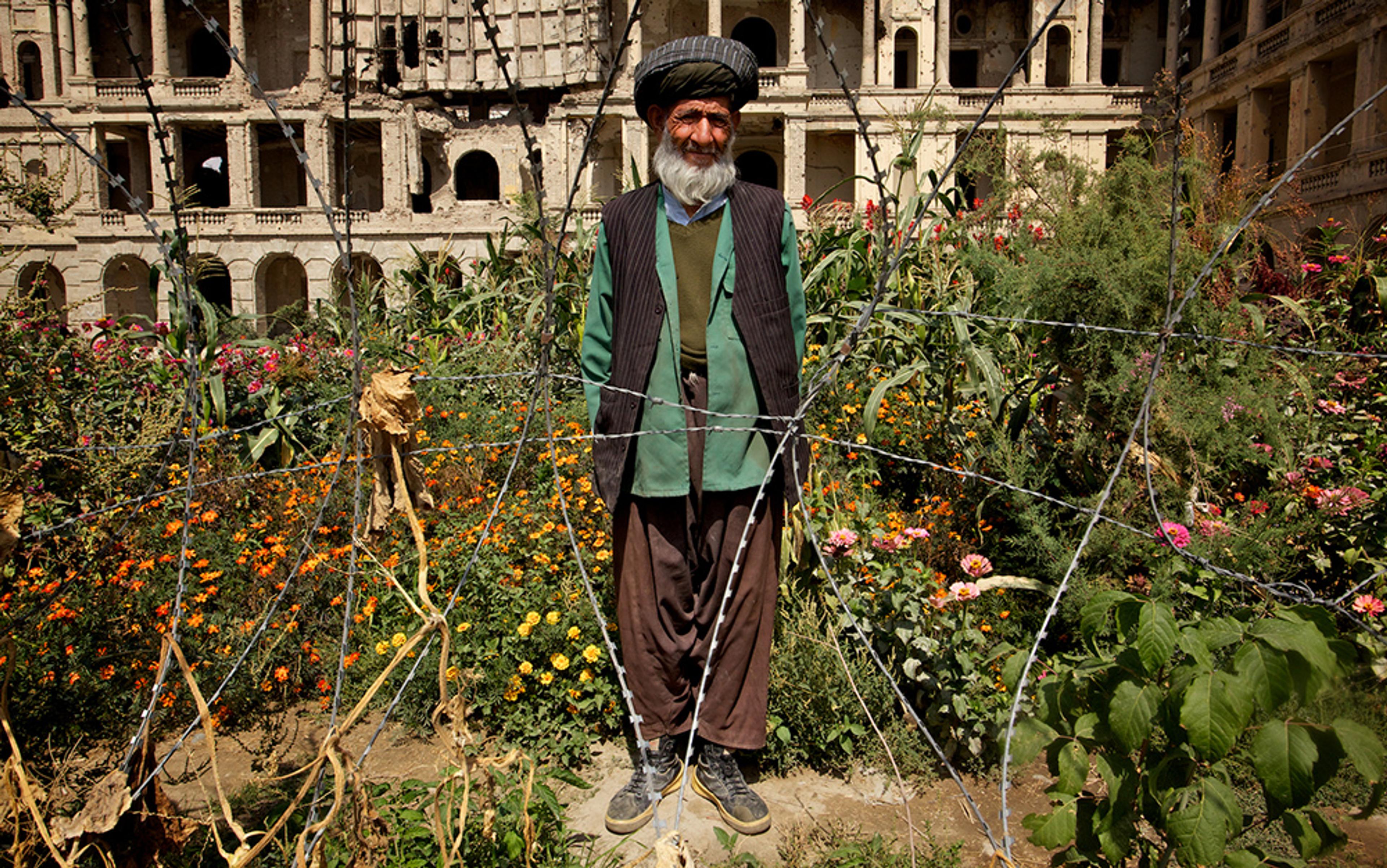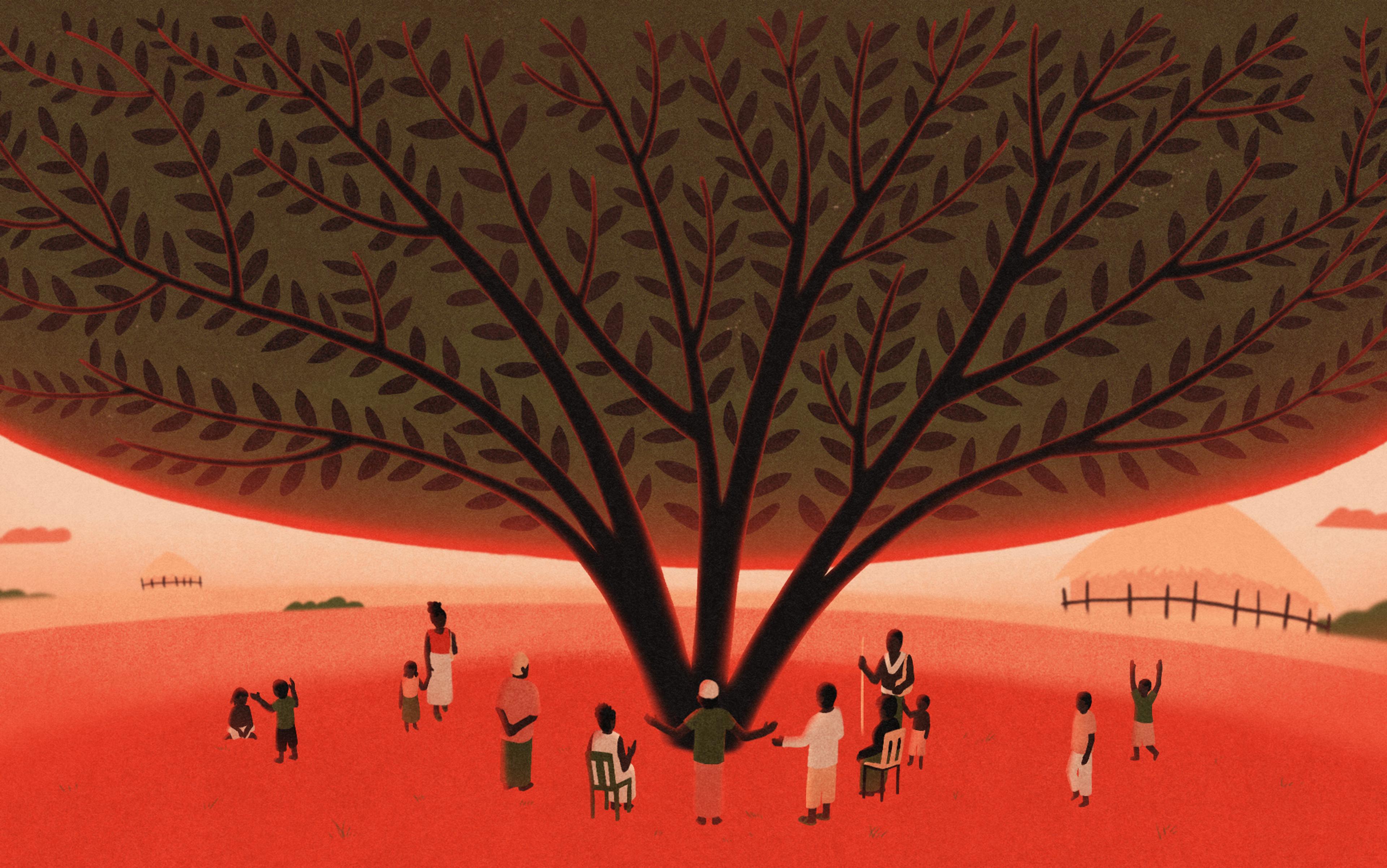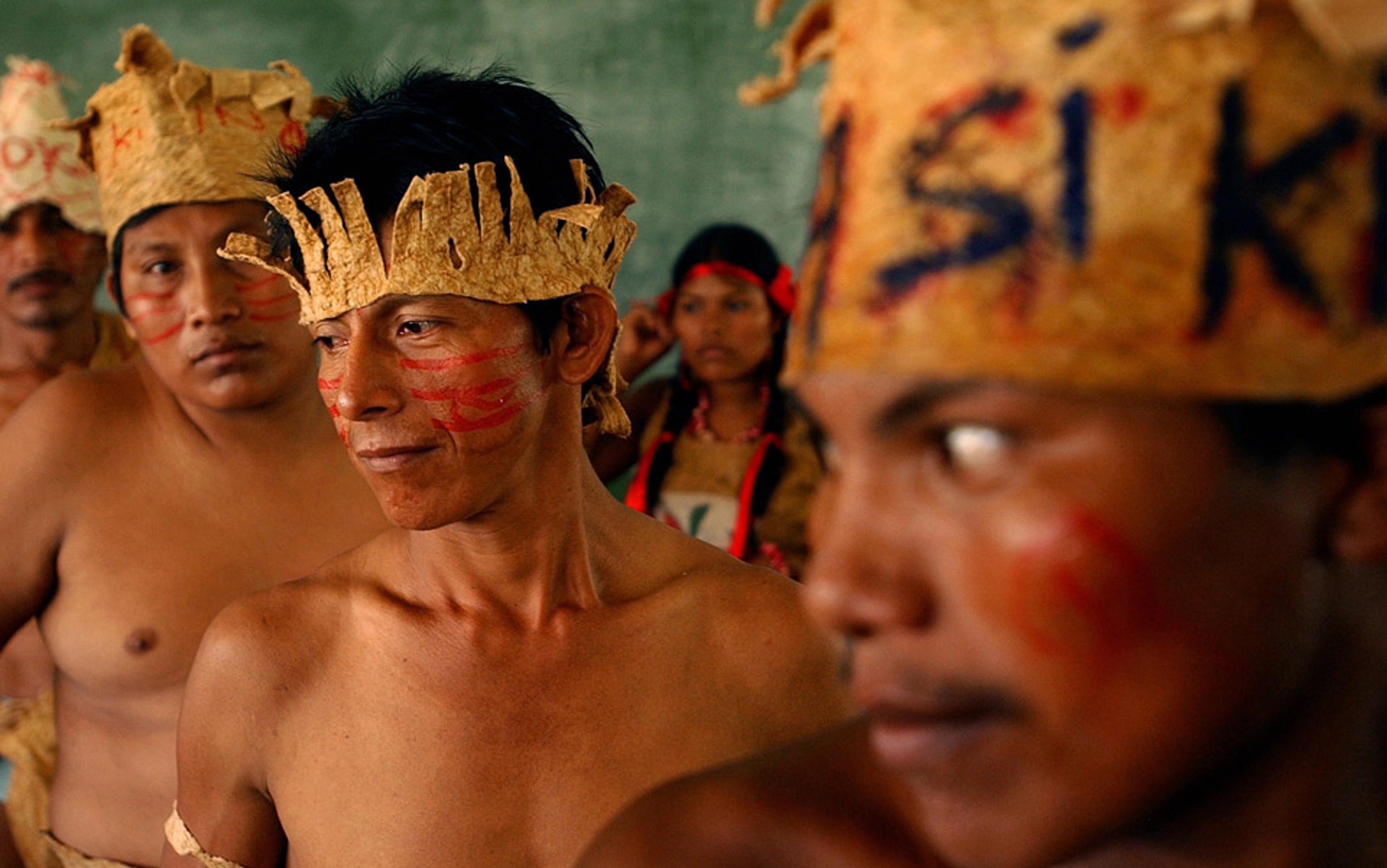One torrid afternoon, I journeyed with an Indigenous Marind woman and her family to a patch of razed forest at the edge of the plantation frontier, where workers had cleared the way for oil palm trees. Her name was Circia*. A mother of three in her late 50s, Circia was imposing, but her footsteps were gentle, almost silent when she led us across the wet soils of Merauke, a district in the Indonesian-controlled western half of New Guinea known as West Papua. The patch of former forest that we travelled toward that hot afternoon in May 2016 was a sacred site that belonged to her clan, forming part of the customary territory of the Marind peoples, which today number around 600 families. Though the Marind rely directly on the forest for their everyday livelihoods and subsistence, Circia had not journeyed here with her three children and nine grandchildren to forage or hunt. They had come to mourn.
Towering piles of felled trees surrounded us, ripped from the soil days earlier to make way for a 50,000-hectare oil palm plantation. Among and between the trees lay the bodies of plants and animals who had once inhabited this sacred place. The air was stiflingly hot and still. It was quiet, too, until a distant chainsaw ripped to life. Somewhere in the remaining patches of forest, plantation workers were clearing the way for more oil palm.
I visited Merauke between 2011 and 2019 while doing long-term ethnographic fieldwork with the Marind. I came to learn how they understood the spread of oil palm in their home of West Papua, which has been under Indonesian rule since the 1960s. But during the 18 months that I lived with Marind communities along the upper banks of the Bian River, Circia and her kin taught me something else: the arts of mourning. This was not only a mourning for people, but for trees, animals and ecosystems.
In our age of planetary unravelling, mourning has become a crucial disposition. It is one that allows us to acknowledge and grieve loss, but also to create or revive connections with more-than-human others. In that way, mourning becomes a form of resistance that pushes against human exceptionalism. It reminds us that we share the world with many other kinds of beings, and that these beings also have their own ways of grieving. But the space shared with other species is complicated. We are not just together in the same world, we are tangled up in each other’s lives. Other species live on and in us, they change us, and we change them, too: we breed them, farm them, mutate their genomes, eat them, research them, love them, and kill them. Increasingly, human action is leading to their extinction. Should we not mourn them, too? Acknowledging the relations that sustain or undermine life and death in multispecies worlds means also learning to practise ‘multispecies mourning’.
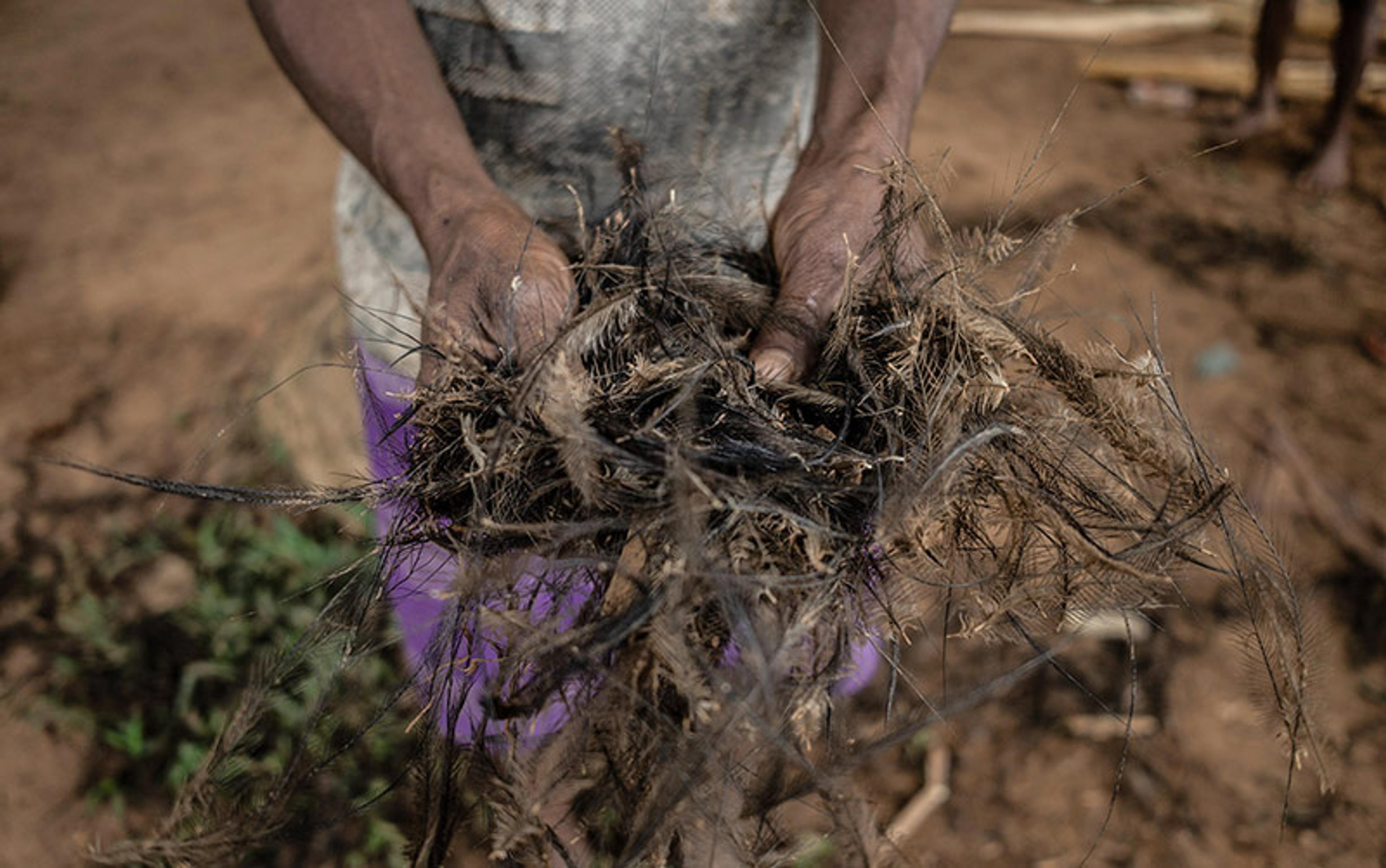
Cassowary feathers salvaged from an oil palm concession by Marind villagers. Photo by Vembri Waluyas
For Circia and the Marind, multispecies mourning can mobilise pain and grief, especially the grief that comes from witnessing profound ecological changes. But it’s not just a form of commemoration and remembering. Mourning resists the trivialisation of lives that aren’t human and the regimes of violence that make more-than-human deaths seem normal or natural. Mourning the deaths of plants, animals and landscapes, as the Marind do, demands that we rethink which deaths deserve grief, which deaths are morally sanctioned, and which are forgotten altogether. It invites us to consider how we might remember those who must die for us to thrive. But how exactly do you mourn a forest?
For three weeks, Circia and her relatives travelled to a razed patch of earth, where they sang songs, wove sago bags, and planted bamboo. They ‘shared skin and wetness’ (a set of practices known as igid dubadub in Marind) with the landscape by crying over it, touching it, smelling it, and storying it. They also cleared waterways to facilitate the movements of animals and smoothed ruts left behind by the bulldozers that were decimating the forest. That way, Circia explained, the earth’s scars could ‘heal’.
Marind communities have traditionally depended on the forest for their everyday subsistence, which they collectively procure through hunting, fishing and gathering. These plants and animals include sago palms, taro, yam, rambutans, papayas, bananas, rusa deer, riverine eels, lorises, possums, cassowaries, fowl, kangaroos, crocodiles and pigs. These sources of food are considered kin by Marind and often referred to as their ‘grandparents’ (amai in Marind) or ‘siblings’ (namek). They share common descent with Marind clans from ancestral spirits (dema) who fashioned them from primordial mud at the beginning of time. Marind relations to their plant and animal kin are grounded in principles of respect, reciprocity and care. Plants and animals grow to feed their human counterparts and, in exchange, humans must perform rituals, exercise restraint and demonstrate reverence towards these organisms and the ecologies they depend upon to survive and thrive.
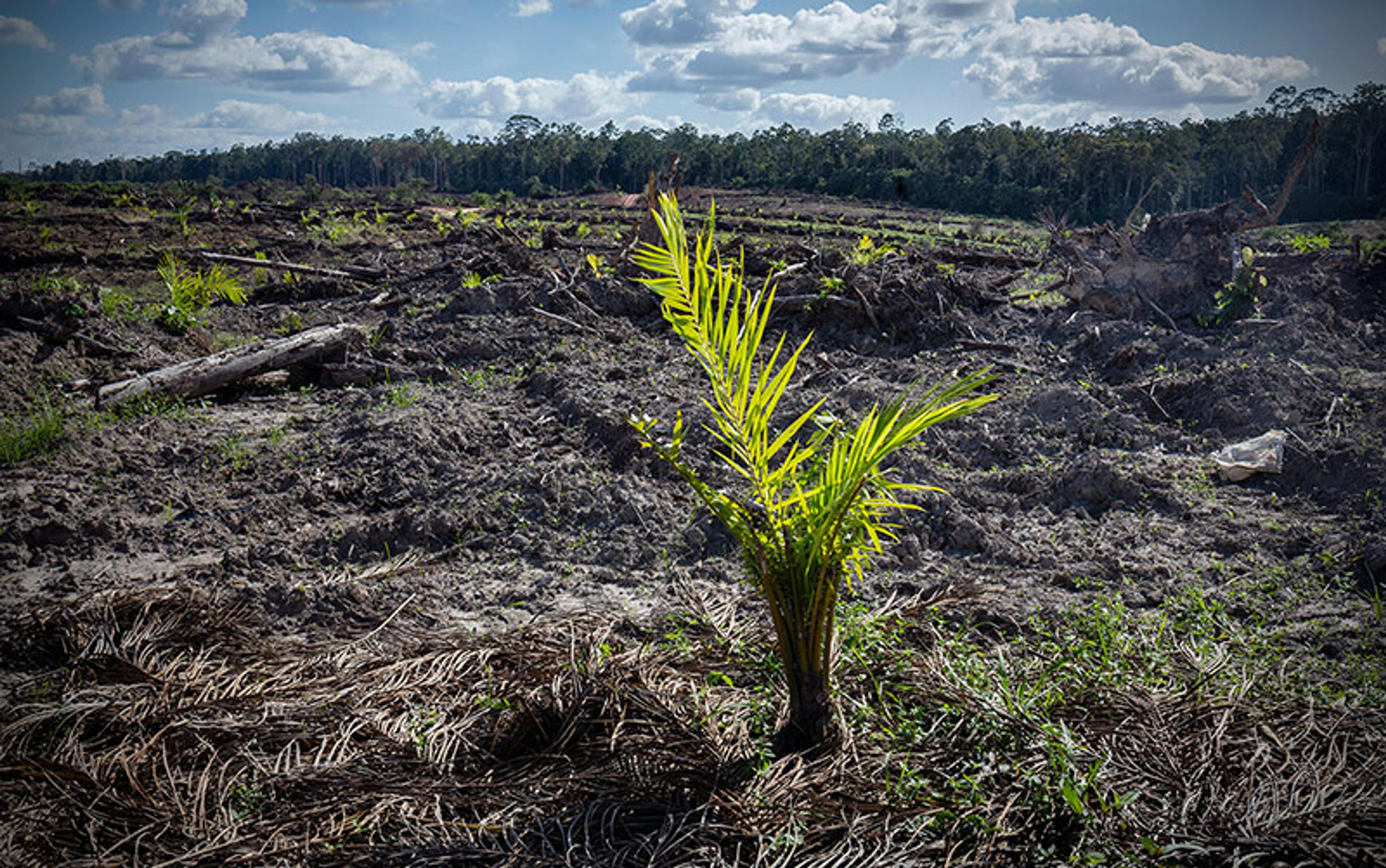
An oil palm seedling in a patch of recently razed forest in West Papua. Photo by Vembri Waluyas
In the past decade, many Marind families in the Upper Bian region have lost their native forests to monocrop plantation projects. Since 2010, the Indonesian government has allocated some 1.2 million hectares of land in Merauke to 36 domestic and international corporations for the development of oil palm, timber and sugarcane plantations. Vast swaths of forest have been felled or burned. Major watercourses have been diverted to irrigate the newly established monocrops. Many Marind villages are now encircled by oil palm and other agribusiness plantations that cover several hundred thousand hectares of former forest and extend north into the neighbouring regency of Boven Digul. Each of these plantations can range in size from 20,000 to more than 300,000 hectares. They creep to the edge of Marind settlements, encroaching on sago groves, hunting zones, sacred graveyards and ceremonial sites.
The relations between the Marind and their kindred plants, animals and elements are being severed
As we enter the third decade of this millennium, more companies are applying for operational permits. Agribusiness continues to expand relentlessly across the region, promoted by the Indonesian government and implemented by domestic and foreign corporations in the name of regional economic development and national food security in staple commodities such as oil palm, rice and sugar. These developments sit within broader processes of large-scale land investments across the tropics, a phenomenon prompted by the food, fuel and finance crisis of 2008 and driven primarily by multinational conglomerates and colluding governments across the Global North and South. The expansion of plantations also exemplifies a broader trend in oil palm expansion across the tropics, in which we are all unwittingly complicit through our daily consumption of myriad products that contain palm oil, such as cosmetics, shampoos, soaps and fast food.
Land privatisation, deforestation, soil erosion, water contamination and air pollution caused by oil palm expansion have radically jeopardised the Marind’s forest-based livelihoods and economies, as well as their food and water security. As forest landscapes give way to industrial monocrops, the relations between the Marind and their kindred plants, animals and elements are being severed. These homogeneous plantations are dominated by oil palm, a single cash crop that was introduced into West Papua in the mid-1980s that many Marind describe as aneh (alien), asing (foreign) and penjajah (colonising). As these plantations encroach further on the forest, the Marind’s capacity to seek nourishment is thwarted, and their intimate and ancestral kinships with native organisms are undermined. Kindred plants and animals struggle to survive in oil palm monocrops, which are characterised by low canopies, sparse undergrowth, unstable microclimates, high temperatures and a toxic mélange of chemical fertilisers, herbicides and pesticides.
Loss follows in the wake of oil palm and, with it, new forms of mourning: Marind women and children weave sago bags as a form of collective healing; villagers create songs in response to roadkill they encounter; and Marind activists plant bamboos to reclaim razed lands by encouraging the growth of native vegetation. Even as forest ecosystems are destroyed and land is privatised, human and more-than-human fates remain indissociable. These arts of mourning are how Marind reckon with radical loss and actively resist the ecocidal logic underpinning the spread of oil palm. Multispecies mourning exemplifies the ways that Papuans Indigenise the planetary crisis and its more-than-human effects through their own dynamic modes of praxis and epistemics. These modes are anchored in a profound awareness of the consequential existences of plants and animals, a responsibility to celebrate their agencies, a creative impulsion to sing and tell stories about a rapidly changing world, and a refusal to live and die by the dominant nature-culture divide that positions human beings as distinct from and superior to the natural world. Together, these practices and philosophies demonstrate how learning to live more justly with other beings also entails learning how to mourn their deaths.
Sitting together in the forest on that sultry afternoon in 2016, I watched Circia’s fingers move swiftly as she twined the sago fibres into a tightly fashioned bag. As she wove, Circia wiped tears off her cheeks and smeared them deep into the moist earth.
For Circia and other Marind women, mourning the deaths of sago, bamboo and other plant and animal beings has prompted the revival of an age-old practice: making noken (handwoven bags). Fashioned by women and girls from filaments of bark and frond obtained from rattan palms, sago palms and gnetum trees, noken are used carry forest products such as vegetables, taro, cassava, kumara, fruit or firewood, and everyday items, including clove cigarettes, mobile phones, school textbooks and bibles. Other types of woven bags are used to transport young pigs – an animal of central significance in Marind ritual, barter and exchange – as well as Marind infants and children.
Noken come in all shapes and sizes: some are square, others are oblong; some are no larger than a child’s palm, others are broader than a man’s chest. Barks and knots ripple across their rough surfaces when first fashioned, but then become silky and soft with prolonged use. Gradually, rain, mud and sweat filter through the material, producing a dark and glossy veneer and a musky fragrance that reminds the Marind of the forest from which the barks and fronds are sourced. Children who fall asleep in noken are pacified by the heat of their mothers’ bodies as it permeates the cloth, but also by the soothing smells and warmth of the bag itself. Babies, infants and toddlers are held in different-sized noken, often produced from materials obtained from the same trees. That way, as Circia explained, sago and children can ‘follow each other’s lives’.
In the past, noken were woven at the birth of a child, the marriage of a relative, or the return of a distant friend. Since the arrival of oil palm plantations, Marind have started to weave noken for less celebratory reasons, such as when they discover patches of razed vegetation in their sacred forests, observe mill effluents spewing into the river, or hear the grumble of approaching bulldozers. These prompt groups of villagers to travel to the forest together and make noken, guided by elder women like Circia. Producing noken is not only an act of weaving, but something that many Marind describe as an act of healing the forest and, by extension, healing themselves.
The women repeat the movements over and over again – skin to skin, bark to bark, frond to fond
Once the group reaches the forest, they break out into small, scattered circles and sit in silence, some with their heads bent low, others observing their surrounds, and many weeping as they remember their experiences and encounters with forest death. This preliminary stage lets people release their pain. The act of weaving that follows involves an intimate mingling of human and vegetal limbs, which many Marind say helps to heal their emotional and physical severance from the forest. Women squat behind their children and guide their fingers along the translucent filaments, one after the other, one within the other. They murmur gently in their apprentices’ ears. ‘This way,’ says Circia. ‘Now that way, now this way again.’ Circia’s younger sister, Petra, chimes in, whispering: ‘The threads, like a river flowing. Your fingers, like a river flowing. All of us, like a river flowing.’
The women repeat the movements over and over again – skin to skin, bark to bark, frond to fond. All the while telling the stories of the species from whom the filaments derive, the forest beings with whom they co-exist, the land on which they thrive, and the different clans with whom they share descent: cassowaries, pigs, possums, tree-kangaroos, birds of paradise, sago grubs, nipa palms, and more.

Weaving sago fibres into noken

Photos by Sophie Chao
Every so often, weavers hand over their half-finished bags to another group member, so that they may weave into it their own wetness and grief. A spiral of movement and materiality forms across the collective, binding them like they bind the bark in their hands, until every bag has passed through the hands of all those present. In the process, the togetherness of noken weaving takes multiple, interconnected forms: the sturdy yet flexible vegetal filaments, the symbiotic species from which these filaments derive, and the kin-bound people who fashion, exchange, gift and wear them.
Noken weaving is as much about making multispecies relations as it is about mourning them. By combining processes of making and mourning, this practice offers a potent way out of the paralysing politics of despair that can arise in the face of generalised ecocide, as industrial processes undermine conditions of life at a global scale. Learning to live with other species also entails learning to mourn the multispecies worlds that disappear with each organismic death. It is this ethos that the Marind invoke as they mourn and celebrate by weaving with their significant human and vegetal others.
Over the past decade, a growing network of roads and highways has spread across the Upper Bian to facilitate the transportation of labourers, equipment and oil palm fruit between settlements, plantations, mills, refineries and ports. Some of these roads are privately owned by corporations and restricted to company personnel. Other projects, such as the Trans-Papuan Highway, have been initiated by the government in the name of regional economic development and transregional connectivity. Along these vast and winding capillaries – made from asphalt, concrete, dust and dirt – ecocide manifests in the form of roadkill: forest beings violently crushed by passing vehicles.
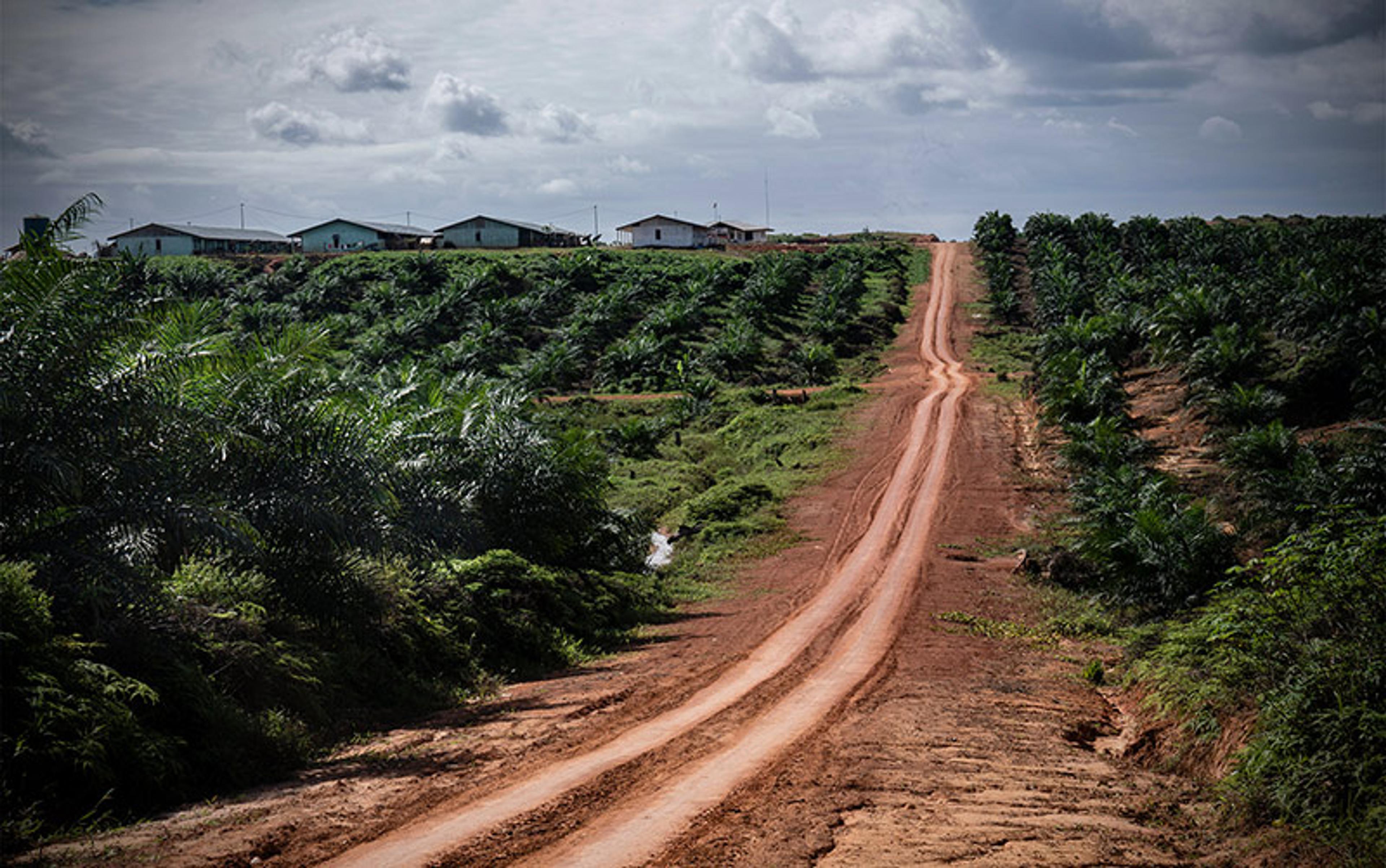
Dirt road leading to an oil palm plantation in rural West Papua. Photo by Vembri Waluyas
As they journey across the landscape, the Marind regularly encounter the mangled bodies, leaking entrails, scattered limbs and blood-stained feathers of their barely recognisable yet all-too-familiar kin. Nothing can be done in the face of these violent and often slow deaths. But, if you are Marind, you must nonetheless stop. You must turn off the engine of your motorbike. You must get off and stand by your dead or dying kin – a feathered ‘sibling’ or shiny-scaled ‘grandparent’. You must not turn away. And you must sing.
Sami, Sami, you slip, you slide
Sister of the forest, sister of the grove
Sami, Sami, you weave, you glide
Sister of the river, sister of the swamp
Your skin is sleek and shiny, patterned by the land
Silent and shy, you slither across the land
Moving soil and leaf, patterning the land.
Here you lie, Sami, snake sister
Your body crushed, your wetness gone
I cannot bear to look at you, I cannot bear to leave
The trucks and cars, they took away your life
Robbed you of your wetness, robbed you of your pride.
Here you lie, Sami, sister snake
I was not here to save you, I could not spare you death
Sami, Sami, in leaves and fronds, I’ll wrap you
With my arms and my legs, I’ll take you
To a quiet, green place, I’ll carry you
To that place where your fathers and forefathers were born.
And there, you will find rest
In the cool shade of the forest, you can sleep
There, no pain or dust will haunt you
The rain and soil will hold you
This nightmare will release you
I beseech you, accept from me this song
Through it you will live on.
These lyrics were composed by Andreas, a Marind youth, upon discovering the pulverised remains of his clan’s sibling, the snake, along a recently constructed stretch of the Trans-Papuan Highway. Songs about roadkill, Andreas explained, celebrate the origins and lifeways of Marind’s more-than-human kin. They speak to the ancestral connections between organisms killed by the road and the individuals who discover them. They also allow the Marind to express their shame for not being present or able to spare their kin a tortuous death in the alien environment of newly built roads.
The villagers stood or kneeled in a circle around the body of a maimed boar
Here, the form of dying matters as much as the fact of death itself. Unlike organisms hunted in the forest and treated with customary ritual care, respect and reverence, organisms killed on the road are flattened into mutilated and disfigured remnants of themselves. If they survive being crushed, they are left to rot, where they will suffer a humiliating and lonely death, gasping for air. Songs about roadkill, then, come to embody a last rite of sorts, and a way of reckoning with the enormity of this form of loss that repeats over and over again across the landscape, under the indifferent weight of passing trucks and cars.
As with weaving, singing-as-mourning is a collective practice. I discovered this during the summer of 2016, when Serafina, a young Marind woman and close friend of mine, encountered roadkill near her home village of Khalaoyam after returning from a fishing expedition. Dropping her nets and harpoons, Serafina wailed to draw the attention of her relatives in the village, who rushed to meet us. The villagers stood or kneeled in a circle around the body of a maimed boar. Then Serafina began to sing in a slow, deep and guttural voice. She was searching for words, swallowing back tears, composing grief. When she stumbled on her words or stopped her singing, another member of the group took over, fleshing out the song with new meanings and memories. Human words were interspersed with mellifluous whistles, deep caws, husky hoots and gravelly grunts – those who did not sing continued to give voice to the voices of those whom they mourned. Sometimes, a bird in the forest will respond with a distant, muted call, which is how the Marind ‘know that the forest is listening’, as Andreas’s younger brother Okto explained. ‘They know that the forest, too, is grieving.’
Songs about roadkill are often accompanied by other acts of commemoration that give forest creatures something akin to a peaceful afterlife after a harrowing and lonely death. The remains are wrapped in fronds, carried to nearby patches of forest, buried in the soil, and covered with offerings of leaves, sago flour, nuts and shoots. People regularly visit and pay their respects to roadkill as they travel a landscape dotted with makeshift burial grounds. They stop to sing new songs and leave small gifts. Often, they bring to the dead the silent companionship of yet another victim recently salvaged from the dusty road. A crushed black-crested bulbul, yellow-feathered and lighter than a betelnut, is laid beside the mangled casque of a cassowary, its feathers and claws stripped and sold by plantation workers. A mature wild boar joins them in the ground, its hair matted with clots of blood and froth. Then Marind sing for the animals’ children and grandchildren, both already-gone and never-to-come. In doing so, they grieve not only the deaths they witness in the present, but also the deaths they anticipate will occur in the near and distant future as oil palm plantations continue to expand relentlessly across their native lands and forests.
Planting constitutes a third art of mourning on the West Papuan oil palm frontier. This involves harvesting juvenile bamboo shoots or rhizomes from the forest and transplanting them along the boundaries of customary territories owned by different Marind clans – particularly where these boundaries intersect with oil palm plantations. It’s a practice introduced by Indigenous Marind land rights activists. On one hand, planting demarcates and reclaims lands wrongfully stolen from the Marind by agribusiness corporations. But planting is about more than defining boundaries. For the Marind, it’s a way of acknowledging a kind of death for which the healing practices of singing and weaving aren’t suited. Singing and weaving serve to commemorate the deaths of specific sites or particular organisms: a patch of sacred forest, or a snake-sibling murdered on the road. Planting as mourning, on the other hand, is directed to death at a scale that is difficult to see, touch or fully comprehend. It is a death that unfurls across the hundreds and thousands of hectares of land now converted to monocrops. It is a death that is distributed across plants and animals, but also the elements and the land itself as it is sapped of its nutrients and minerals through monocultural exploitation. Planting seeks to recreate vegetal life within and against the plantation itself as a zone of death.
Solemnly and silently, villagers get to their knees, dig with their bare hands, and carefully place the rhizomes they have harvested from the forest into the ground before covering them up with a light layer of soil. Then, the group members utter prayers and words of thanks to the forest and the bamboo for its presence and nourishment. They enumerate the many animals and plants who have died here because of oil palm, and who therefore must be mourned. They entice the bamboo to grow fast, wide and well, so that it might offer food and shade to those who encounter it. They exhort the bamboo not to get sick or die, like so many others, but rather to flourish.
These utterances are enhanced by physical exchanges of skin and wetness, as villagers rub their tears and sweat onto the rhizomes as they bury them and along the smooth surface of previously planted stems. The growth of bamboo signals that the plant has listened to peoples’ voices and imbibed their life-sustaining wetness.
Planting bamboo is uncannily effective in undermining the operations of the plantations
The plants selected by the Marind, primarily the Nastus genus of bamboo, are characterised by their resilience and fast growth. Remarkably tolerant of both drought and waterlogging, Nastus bamboos develop from short rhizomes that grow into large, dense clumps. Each plant produces new shoots throughout the year, growing up to 30 centimetres daily before reaching a maximum height of up to 30 metres in their first year.
Pointing out the tangled, sturdy shoots of a bamboo cluster, Paskalus, a young man from Khalaoyam village, explained:
Bamboos are like Marind. Tall, strong and resilient. They know how to live with drought and monsoon, and forest and swamp. Their roots extend far and wide, holding the soil together. Bamboos do not know how to live alone. Instead, they grow with each other, close to one another, like this bamboo cluster, right here.
Paskalus then directed my gaze to the canopy, where towering mature bamboo stalks swayed in the mid-morning breeze. The sunlight reflected off their smooth surfaces down into the undergrowth, where smaller shoots were emerging from the soil. Paskalus ran his fingers up and down the stems and said: ‘The elderly ones, the young ones, the tall and short ones – they grow together and so they grow stronger.’
Though used in mourning practices, planting bamboo is also uncannily effective in undermining the operations and effectiveness of the plantations that state and corporate entities seek to control. For instance, bamboo shoots are largely invisible, subterranean and consequently overlooked. They lie dormant at first, and then erupt as they proliferate, creep and climb along and across each other to form thick clusters that are relatively resistant to herbicides and almost impossible to fully eradicate. Moving, cutting, unearthing and spraying eradicates bamboo only if all roots, shoots, rhizomes and culms are broken up and removed. If even the tiniest, stray fragment of a root remains in the ground, new growths will form, and the bamboo will multiply all over again, turning once-uniform oil palm monocrops into thickly overgrown, unwieldy landscapes, and therefore more expensive and difficult to manage.
Bamboo shares ‘wetness’ with the Marind activists who manually replant it, wipe their tears into it, and entice it to grow. The plant’s fast growth and resiliency make it a partner in Marind struggles for territorial and environmental justice. Planting bamboo will never compensate for the vastness of death that oil palm plantations generate, but it’s nonetheless a powerful form of mourning-as-resistance. To replant bamboo is an act that commemorates the dead and helps break up the homogeneity of industrial oil palm landscapes.
During the past decade, Marind communities on the West Papuan plantation frontier taught me many forms of mourning. Weaving noken commemorates the shared injuries suffered by the forest and the humans who live on the plantation frontier. Singing eulogies refuses indifference to the fate of animals violently killed by cars and trucks. And planting bamboo challenges the homogeneity of monocrop landscapes and the innumerable plant and animal deaths that these landscapes produce.
The Marind peoples are aware that mourning alone will not achieve the social change needed to halt planetary ecocide. But these arts of mourning still matter. They mobilise pain – of humans and their many kin – to resist the trivialisation of regimes of violence that naturalise the deaths of plants, animals or forests. They are modest and resilient, poetic and political. They embody collective modes of reckoning, refusal and resistance. Cultivating arts of mourning demands that we envision a future not just by looking forward, but also by looking back – by remembering those who have been obliterated in the name of productivity and profitability. In Merauke, along the upper banks of the Bian River, arts of mourning draw together human and more-than-human worlds through shared planting, singing, weeping and weaving.
We sat cross-legged by the bamboos, running our fingers across the stalks like we had with Circia
I last visited Merauke in June 2019. Serafina told me that her grandmother Circia had died a few months earlier from pneumonia. I asked to visit the site where Circia had once taught us how to weave noken, but Serafina replied that this was not possible. The former patch of forest had since been planted with oil palm and fenced off with barbed wire. Instead, Serafina suggested we pay Circia a visit.
I was led by hand to the boundary of an oil palm concession located near Serafina’s home village. Here, between road and plantation, a row of fresh bamboo shoots rose green and translucent from the dirt. Circia had replanted them a few weeks before her passing. Short of breath and ridden with arthritic pains, she had painstakingly harvested the shoots from a part of the forest that was soon to be cleared for oil palm. She nurtured them in a plot of soil near her hut, and then gave them a new home at the edge of the concession.
Serafina and I spoke of Circia’s weaving, singing and planting until the sun set. We sat cross-legged by the bamboos, running our fingers across the stalks like we had when Circia enskilled us in the art of making noken. Though she was no longer with us, she left in her wake a place of meaningful mourning and continuance – a place where death and emergence were intertwined. Even in her afterlife, Serafina explained, Circia’s presence continued in the bamboo shoots thriving around us and in the arts of mourning she had taught us.
* Pseudonyms have been used throughout for reasons of security and privacy.
This essay is derived in part from Sophie Chao’s article ‘Multispecies Mourning: Grieving as Resistance on the West Papuan Oil Palm Frontier’ published by the journal Cultural Studies (Taylor & Francis, 2022)
